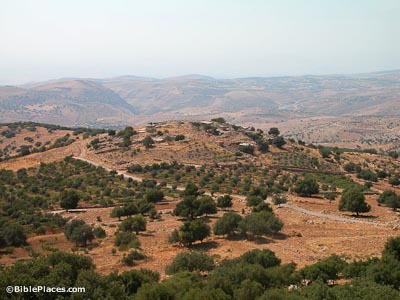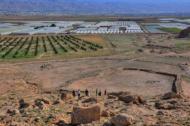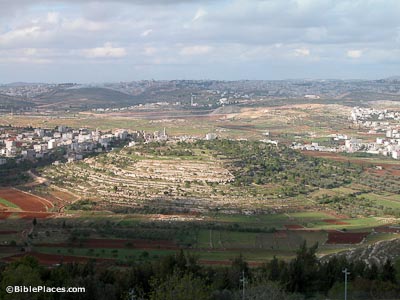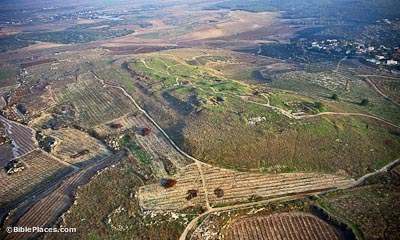 |
| site of Tishbi in Gilead, home of the Prophet Elijah, courtesy, BiblePlaces.com |
Gilead was an ancient region lying on the
east side of the Jordan in what is today, the Arab-occupied Hashemite Kingdom of Jordan. It was also
the site of a town of the same name where a treaty
was proclaimed between Jacob who, with his family, had fled from the house of
Laban his father-in-law in Aram Dimashq, and Laban himself. After the Exodus
and Joshua’s conquests, the region of Gilead was allotted mostly to the tribe
of Gad with the remainder going to the half-tribe of Menasheh. The town of Ramot Gil’ad, according to Joshua 20:8,
became one of the Levitical cities as well as a city of refuge. Yavesh Gil’ad was the principal city
and first mentioned in connection with the war between the Benjaminites
and the other tribes of Israel. Because the local Gadites had refused to march
against the Benjaminites, 12,000 Israelites were sent against them. All the
people of the city were slain except 400 virgins who were spared only to be
given as wives to the surviving Benjaminites. In the beginning of the reign of
Saul, the city was attacked by Nahash, King of Ammon, and was forced to apply
to Saul for help. The inhabitants of Yavesh Gil’ad remained grateful to Saul
for his assistance, and when he and his three sons were killed by the
Philistines on Mount Gilboa, they went by night, took the bodies from the wall
of Beth She’an, brought them to Yavesh, burned them, buried the remains, and
fasted seven days. For this deed, Yavesh Gil’ad was afterward highly lauded. Much later, during the period of the divided Kingdom, there preached the Prophet Elijah, a native of the town of Tishbi located in Gilead.
During the Islamic period, the territories on the east side
of the Jordan, being so close to the Arabian Desert, were one of the first of
the ancient Israelite territories to be settled by Arab tribes, and throughout
the centuries, both Arab and Jewish Bedouin would traverse the area.
Ajlun (the Arabic name for Gilead) was an important Jewish
center in the Middle Ages. In the 12th century, the Spanish
Jewish traveler and explorer Benjamin of Tudela wrote of a Jewish community in
Ajlun with a population of 60 families lead by three sheikhs – Zadok, Yitzhak,
and Shlomo. For a period of time, the rabbis of Jerusalem debated whether
certain parts of the territories east of the Jordan, including Ajlun, were part
of the Land of Israel according to halacha, and therefore subject to the laws
that can only be observed in Israel. People often expressed their opinions, but
one opinion that carried much weight was that of the Palestinian geographer
Ashturi HaParhi who considered the town as part of Israel. The matter was
finally settled at the end of the 16th century when Ajlun,
along with other towns in the area, were officially considered a part of Israel
according to halacha. (NOTE: At that time, whether a rabbinic authority was pro
or con, no one even discussed the possibility of uprooting Jews from there. And
the Jews from there never said that they were there in order to protect Jaffa.)
In 1879, the region was proposed as a place of Jewish
settlement by the English adventurer Laurence Oliphant. By that time, Ajlun had
long been abandoned but there was still an intermittent Jewish presence in the
region among the local Bedouin. Many Jews would come to Jerash, for example, for trade making that town, a major commercial
center, a status it retained until the 1920s.
In the 1890s, one of the earliest halutzim, Isaiah
Rafalovich, lived for a while in es Salt.
During World War I, the Battle of es Salt, one of many battles that were fought
in the Gilead region, and fought between the Turks and the Jewish Legion, was
among the most decisive battles in the War that allowed the British to take
control of Palestine. When the British authorities created Transjordan in 1922,
the territories east of the Jordan, including Gilead, became off limits to
Jews. Today, in spite of the peace treaty with Jordan, the ban on Jewish
residency in the area is still in force.








